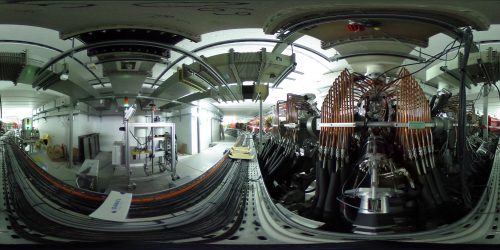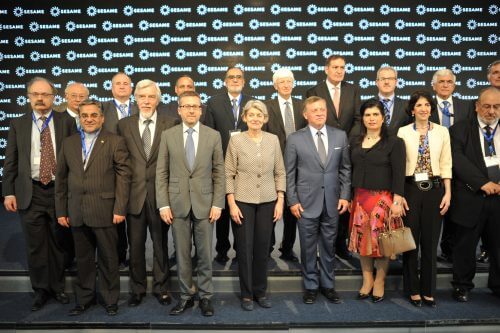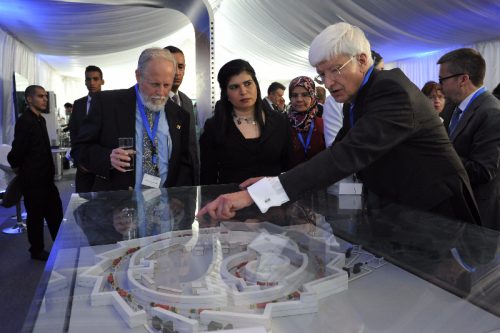The Middle East particle accelerator is launched. The construction of "Sesame" was recently completed as part of a unique scientific and political collaboration supported in Israel by the Ministry of Science and the National Academy of Sciences. Scientists from Iran, Turkey, Jordan, Egypt, Pakistan, Cyprus, the Palestinian Authority and Israel will collaborate in the project for the first time. So far, 55 proposals have been submitted by researchers from the region for research in the accelerator.

The accelerator was inaugurated yesterday, May 16, 2017, in a solemn ceremony in Jordan in the presence of King Abdullah II of Jordan, Princess Sumia bint Al-Hassan of the Jordanian royal family, Director General of the Ministry of Science and Technology Peretz Vezan, Chief Scientist at the Ministry of Science Prof. Alexander Blei, President of the Israel National Academy of Sciences Prof. Neely Cohen and delegations from around the Middle East and the world. The Israeli delegation - about 25 representatives from the academy, the Ministry of Science and other government ministries - was the largest at the ceremony.
The "Sesami" particle accelerator is a circular facility the size of a stadium that creates electromagnetic radiation by accelerating electrons to a speed close to the speed of light. The state-of-the-art accelerator will be used by researchers from the countries of the region in the fields of life sciences, physics, chemistry, materials science and more. The accelerator can even help in deciphering archaeological finds and measuring contamination in the environment. The accelerator is located near the city of Alan, about 40 minutes drive from Amman, the capital of Jordan.
The director general of the Ministry of Science, Peretz Vezan, said at the ceremony that "through regional cooperation, we hope to strengthen relations with neighboring countries. The scientific cooperation will seep into cooperation in other fields. Through connections and alliances and by seeking opportunities with our neighbors together we will advance the region and be ready for the challenges of the 21st century."
Princess Sumiya said that Jordan is devoted to the wonderful project and is committed to equality between those involved in the project regardless of race and religion. "We want to allow scientific investigation to thrive and flourish. Science has the potential to shed light on the region and bring about a better life for all. I personally had the pleasure of seeing the development of Sesami, which serves as an example of the diplomacy of science." The princess noted that Jordan is a partner in other projects under the slogan of 'Science for Peace' and that science contributes to the regional discourse."

Iran's ambassador to Jordan Mojtaba Ferdosi said: "The accelerator's dream has come true. This is the most important scientific project in the region that will surely give a shot of encouragement to the research activity between the countries and bring the countries in the region to cooperation and achievements. On behalf of the Iranian scientists, I invite you to work with us, share the scientific achievements and promote science in the Middle East. Iran supported the project from the beginning and participated in it financially and technologically. Sesmi is a basis for scientific cooperation in the region and for improving our relations with our neighbors."
"The facility will be a meeting place for scientists and a possible arena for scientific collaborations," says Prof. Eliezer Rabinovitch from the Hebrew University of Jerusalem, chairman of the National Academy of Sciences Committee for High Energies, which has promoted the project for the past 20 years. "The determination and partnership of scientists and other factors in the region and beyond has proven that even though there are many difficulties, it is possible to build a scientific lighthouse in our regions that radiates hope for a different way of life. Science was a universal language that connected the scientists and the countries in the region. From the moment the accelerator is launched, it will be evaluated according to its scientific achievements."
Dr. Khaled Token, the director of the project and a former minister in the Jordanian government, said in his speech that "building Sesmi was not easy. We had to overcome budgetary, technological and political challenges. Many challenges still remain, but this is the end of an era and the beginning of a new one. Special thanks to all the governments that saw the light in the goals of Sesami."
The beginning of the project with researchers from the region, from Germany, the USA and Israel who wanted to establish in the Middle East an accelerator similar in terms of its human goals to those of the accelerator at CERN. In 1997, the Ministry of Science and the National Academy of Sciences joined the initiative, based on the concept that scientific cooperation in the region would not only benefit scientific development but also lead to mediation and understanding between the countries of the Middle East. In 2003 the cornerstone was laid for the facility and in November 2008 the construction of the building that will house the particle accelerator was completed. In addition to the member states of the accelerator, the European Union, Italy, UNESCO and Germany donated millions of dollars to the project and laboratories from around the world donated scientific equipment worth an additional 20 million dollars. Over the years, Israel has invested about NIS 40 million in the construction of the accelerator.

Sesame's scientific goals are different from those of the accelerator in Geneva. The seven light beams that will operate in the accelerator, two of which will start operating as early as next month, will allow scientists to study the properties of different materials. The first beam of light to operate will be used to study air pollution in the Jordan Valley by examining the presence of metals in soil samples. Another beam will provide radiation waves that will make it possible to study cancer cells and other biological tissues.
There are about 60 similar particle accelerators in the world. Sesami is a modern, innovative accelerator and the only one of its kind in the Middle East. Israeli scientists and research students are expected to use the infrastructure offered by the accelerator in the coming years. For the convenience of the researchers, dormitories will also be built next to the accelerator.

7 תגובות
As much as you can get an impression from the article -
An important and inspiring project and great hope.
The cooperation between people from the mentioned countries is almost imaginary.
I am attaching a prayer and hope for the success of the project and the activity at the facility
and for the success of research that will be carried out in it.
As much as you can get an impression from the article -
An important and inspiring project and great hope.
The cooperation between people from the mentioned countries is almost imaginary.
I am attaching a prayer and hope for the success of the project and the activity at the facility
and for the success of research that will be carried out in it.
Bouncer:
You exaggerate with the ".."
Again and again it turns out that the "know-it-all" father is the "expert" on every subject
There is something to comment on and "enrich" the readers with his "wisdom",
It is quite certain that Khamenei has not heard of this project.
As soon as this is known to him, the Iranian scientists will be imprisoned for many years, or will be led in honor to Assad's crematoria.
And Iran's ambassador to Jordan will have to ask for political asylum in Jordan.
I wonder how the security issue is overcome. Almost every scientist comes from a country where there are those who want in other countries (or countries) those who want to hurt him. Sunni Shia Jews Christians
really exciting
A positive and unusual scientific and political achievement in our region,
which gives hope for the future of scientific and economic development and cooperation.
This is the only way to peace and well-being.
Kudos to the initiators and implementers.
You are the real leaders of the peoples of the area